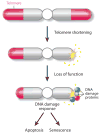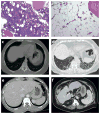Syndromes of telomere shortening
- PMID: 19405848
- PMCID: PMC2818564
- DOI: 10.1146/annurev-genom-082908-150046
Syndromes of telomere shortening
Abstract
Telomeres and telomerase were initially discovered in pursuit of questions about how the ends of chromosomes are maintained. The implications of these discoveries to age-related disease have emerged in recent years with the recognition of a group of telomere-mediated syndromes. Telomere-mediated disease was initially identified in the context of dyskeratosis congenita, a rare syndrome of premature aging. More recently, mutations in telomerase components were identified in adults with idiopathic pulmonary fibrosis. These findings have revealed that the spectrum of telomere-mediated disease is broad and includes clinical presentations in both children and adults. We have previously proposed that these disorders be collectively considered as syndromes of telomere shortening. Here, the spectrum of these disorders and the unique telomere genetics that underlies them are reviewed. I also propose broader clinical criteria for defining telomere-mediated syndromes outside of dyskeratosis congenita, with the goal of facilitating their diagnosis and highlighting their pathophysiology.
Figures





Similar articles
-
The molecular genetics of the telomere biology disorders.RNA Biol. 2016 Aug 2;13(8):696-706. doi: 10.1080/15476286.2015.1094596. Epub 2015 Sep 23. RNA Biol. 2016. PMID: 26400640 Free PMC article. Review.
-
Dyskeratosis congenita: telomerase, telomeres and anticipation.Curr Opin Genet Dev. 2005 Jun;15(3):249-57. doi: 10.1016/j.gde.2005.04.004. Curr Opin Genet Dev. 2005. PMID: 15917199 Review.
-
Telomerase and idiopathic pulmonary fibrosis.Mutat Res. 2012 Feb 1;730(1-2):52-8. doi: 10.1016/j.mrfmmm.2011.10.013. Epub 2011 Nov 4. Mutat Res. 2012. PMID: 22079513 Free PMC article. Review.
-
Recent progress in dyskeratosis congenita.Int J Hematol. 2010 Oct;92(3):419-24. doi: 10.1007/s12185-010-0695-5. Epub 2010 Oct 1. Int J Hematol. 2010. PMID: 20882440 Review.
-
Telomere shortening and loss of self-renewal in dyskeratosis congenita induced pluripotent stem cells.Nature. 2011 May 22;474(7351):399-402. doi: 10.1038/nature10084. Nature. 2011. PMID: 21602826 Free PMC article.
Cited by
-
RNA-protein binding interface in the telomerase ribonucleoprotein.Proc Natl Acad Sci U S A. 2011 Dec 20;108(51):20333-8. doi: 10.1073/pnas.1100270108. Epub 2011 Nov 28. Proc Natl Acad Sci U S A. 2011. PMID: 22123986 Free PMC article.
-
Telomere length and genetic variation in telomere maintenance genes in relation to ovarian cancer risk.Cancer Epidemiol Biomarkers Prev. 2012 Mar;21(3):504-12. doi: 10.1158/1055-9965.EPI-11-0867. Epub 2012 Jan 20. Cancer Epidemiol Biomarkers Prev. 2012. PMID: 22267287 Free PMC article.
-
Aging, Cancer, and Inflammation: The Telomerase Connection.Int J Mol Sci. 2024 Aug 5;25(15):8542. doi: 10.3390/ijms25158542. Int J Mol Sci. 2024. PMID: 39126110 Free PMC article. Review.
-
GDF15 is an epithelial-derived biomarker of idiopathic pulmonary fibrosis.Am J Physiol Lung Cell Mol Physiol. 2019 Oct 1;317(4):L510-L521. doi: 10.1152/ajplung.00062.2019. Epub 2019 Aug 21. Am J Physiol Lung Cell Mol Physiol. 2019. PMID: 31432710 Free PMC article.
-
Telomere phenotypes in females with heterozygous mutations in the dyskeratosis congenita 1 (DKC1) gene.Hum Mutat. 2013 Nov;34(11):1481-5. doi: 10.1002/humu.22397. Epub 2013 Sep 11. Hum Mutat. 2013. PMID: 23946118 Free PMC article.
References
-
- Am. Thorac Soc./Eur Respir Soc Int Multidiscip. Consensus Classific Idiopathic Interstitial Pneumonias This joint statement of the American Thoracic Society (ATS), and the European Respiratory Society (ERS) was adopted by the ATS board of directors, June 2001 and by the ERS Executive Committee, June 2001. Am J Respir Crit Care Med. 2002;165:277–304. - PubMed
-
- Allsopp RC, Morin GB, DePinho R, Harley CB, Weissman IL. Telomerase is required to slow telomere shortening and extend replicative lifespan of HSCs during serial transplantation. Blood. 2003;102:517–20. - PubMed
-
- Alter BP. Diagnosis, genetics, and management of inherited bone marrow failure syndromes. Hematol Am Soc Hematol Educ Program. 2007;2007:29–39. - PubMed
Publication types
MeSH terms
Substances
Grants and funding
LinkOut - more resources
Full Text Sources
Other Literature Sources
Medical

